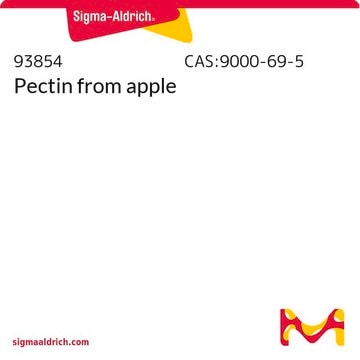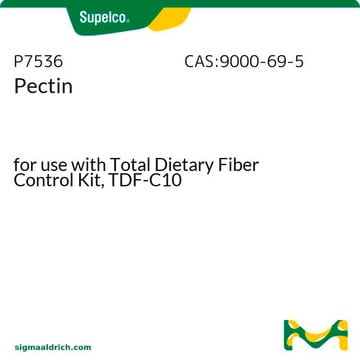P9135
Pectin from citrus peel
Galacturonic acid ≥74.0 % (dried basis)
Synonym(s):
Poly-D-galacturonic acid methyl ester
Sign Into View Organizational & Contract Pricing
All Photos(3)
About This Item
Recommended Products
biological source
citrus (peels)
form
powder
composition
Galacturonic acid, ≥74.0% (dried basis)
impurities
≤10% Moisture
color
light brown
storage temp.
room temp
Looking for similar products? Visit Product Comparison Guide
General description
Pectin is a polysaccharide is rich in galacturonic acid and possesses a complex structure and function.
Application
Pectin from citrus peel has been used:
- in the comparative study of physicochemical, rheological and gelling properties of pectin among different extraction method
- in starch suspension for measuring in vitro starch digestibility
- to measure pectinase activity
- in the production of pectinase on solid medium
Biochem/physiol Actions
Pectin is essential for plant development including growth, morphological changes and immunity. It serves as a stabilizing polymer and is useful in food and speciality products.
Pectin, a heterosaccharide component of terrestrial plant cell walls, is used as a substrate to identify, differentiate and characterized pectinase(s). Pectin is used to study its degradation by pectinolytic bacteria.
Other Notes
To gain a comprehensive understanding of our extensive range of Polysaccharides for your research, we encourage you to visit our Carbohydrates Category page.
Storage Class Code
11 - Combustible Solids
WGK
nwg
Flash Point(F)
Not applicable
Flash Point(C)
Not applicable
Personal Protective Equipment
dust mask type N95 (US), Eyeshields, Gloves
Certificates of Analysis (COA)
Search for Certificates of Analysis (COA) by entering the products Lot/Batch Number. Lot and Batch Numbers can be found on a product’s label following the words ‘Lot’ or ‘Batch’.
Already Own This Product?
Find documentation for the products that you have recently purchased in the Document Library.
Customers Also Viewed
Optimization study of citrus wastes saccharification by dilute acid hydrolysis
Talebnia F, et al.
BioResources, 3(1), 108-122 (2012)
Influence of non-starch polysaccharides on the in vitro digestibility and viscosity of starch suspensions
Sasaki Tomoko and Kohyama Kaoru
Food Chemistry, 133(4), 1420-1426 (2012)
Wenjun Wang et al.
Ultrasonics sonochemistry, 70, 105322-105322 (2020-09-10)
In this study, modified citrus pectin treated with a combination of microfluidization and ultrasonication was compared to the original and ultrasonication treated pectin on hydrodynamic diameter, molecular weight, polydispersity, zeta potential, apparent viscosity, Fourier-transform infrared spectroscopy (FTIR), 2,2-diphenyl-1-picryl hydrazyl (DPPH)
Caroline C Kim et al.
The ISME journal, 13(6), 1437-1456 (2019-02-08)
Pectin is abundant in modern day diets, as it comprises the middle lamellae and one-third of the dry carbohydrate weight of fruit and vegetable cell walls. Currently there is no specialized model organism for studying pectin fermentation in the human
Extraction of pectin from navel orange peel assisted by ultra-high pressure, microwave or traditional heating: A comparison
Guo X, et al.
Carbohydrate Polymers, 88(2), 441-448 (2012)
Our team of scientists has experience in all areas of research including Life Science, Material Science, Chemical Synthesis, Chromatography, Analytical and many others.
Contact Technical Service








